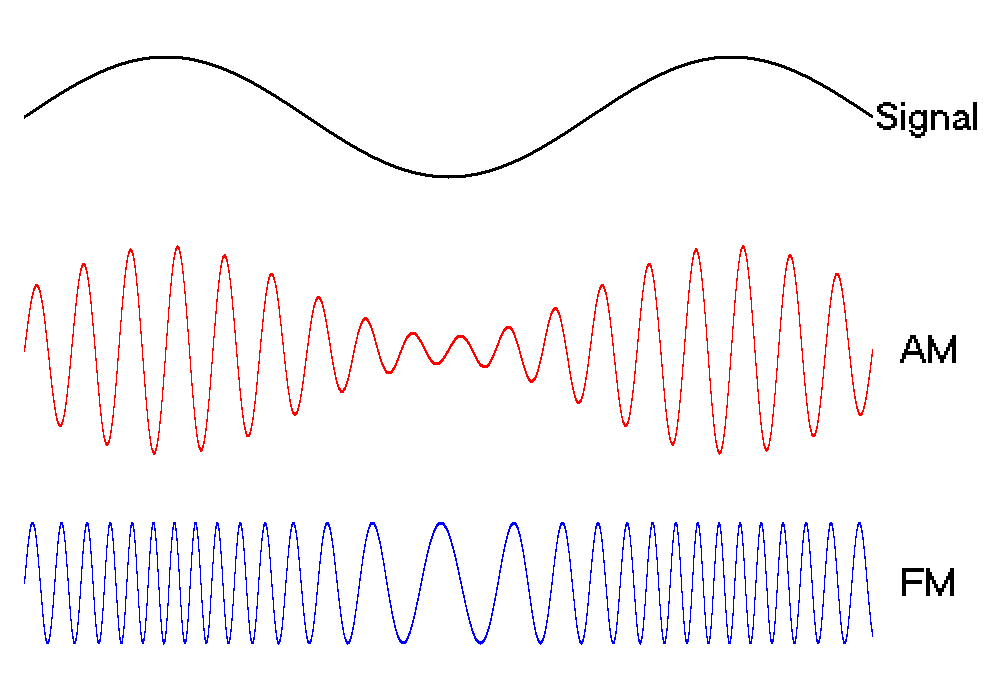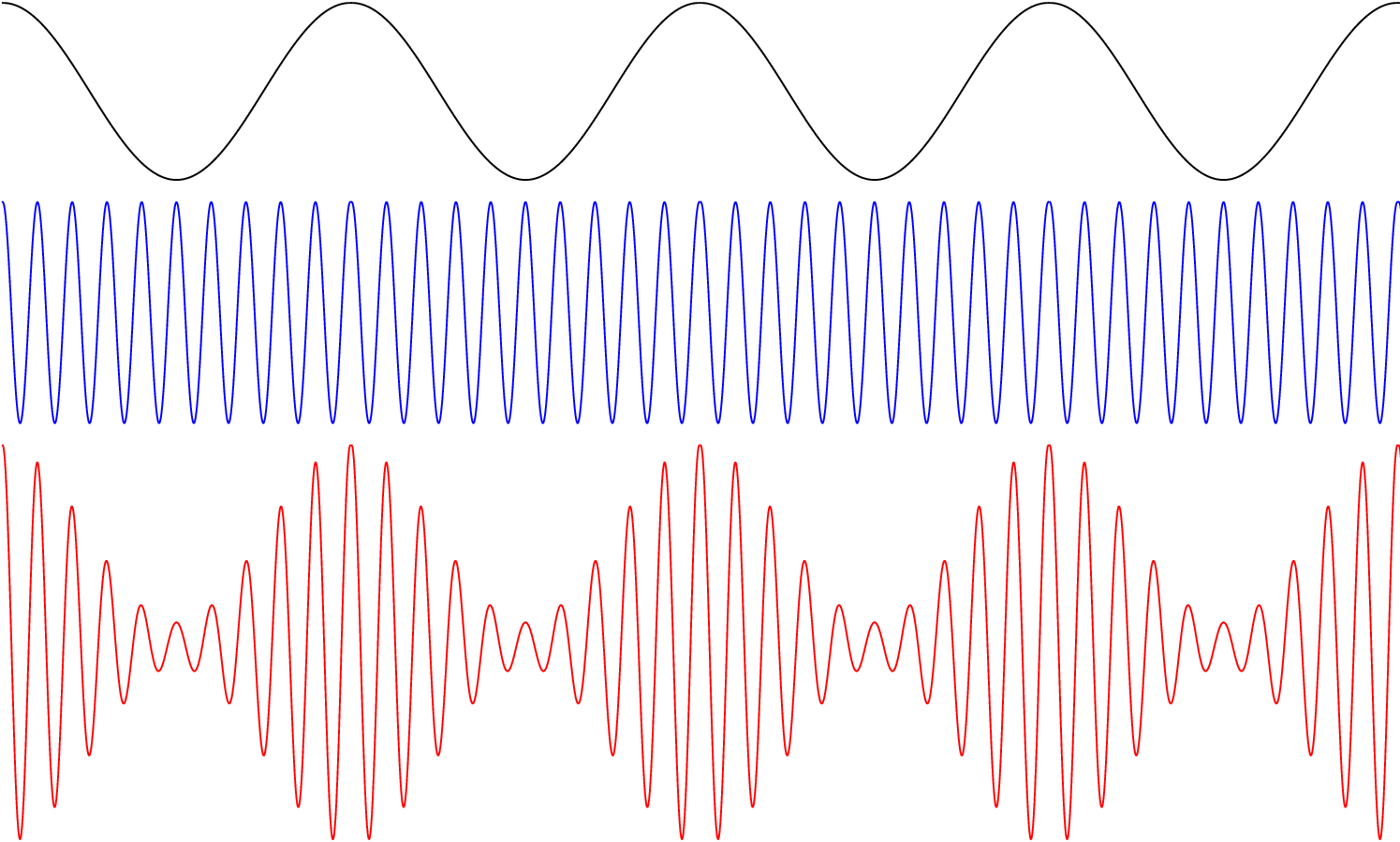
我希望获得一些帮助来获得像这样的调制 FM 信号的动画:
这是我目前拥有的代码:
代码
\documentclass{article}
\usepackage{pgfplots}
\pgfplotsset{compat=newest}
\usepackage{tikz}
\usepackage{media9}
\usepackage{animate}[2014/11/27]
\usepackage{amsmath}
\begin{document}
\begin{animateinline}[
%poster=1, % sin 2x (frames are numbered in zero-based manner)
width=12cm,
height=6cm,
label=graph_switch,
begin={\begin{tikzpicture}},
end={\end{tikzpicture}},
step
]{0}
% Carrier Signal
\begin{axis}[
hide axis,
%xlabel={$x$},
%ylabel={$\text{sin}(x)$},
xmin=-4*pi,xmax=4*pi]
\addplot[black,samples=101] {5*cos(x*180./pi)};
\end{axis}
% Modulating Signal
\begin{axis}[
hide axis,
%xlabel={$x$},
%ylabel={$\text{sin}(x)$},
xmin=-4*pi,xmax=4*pi]
\addplot[blue,samples=501] {5*cos(6*x*180./pi)};
\end{axis}
% Modulated Signal
\begin{axis}[
hide axis,
%xlabel={$x$},
%ylabel={$\text{sin}(x)$},
xmin=-4*pi,xmax=4*pi]
\addplot[red,samples=501] {5*cos(x*180./pi)*5*cos(6*x*180./pi)};
\end{axis}
\end{animateinline}
\end{document}
答案1
您正在寻找 AM 示例。(有关 FM,请参阅↗后续问题。
绘制的方程式略有修改(根据维基百科页面↗幅度调制)。
以下是使用xsavebox包。这节省了最终 PDF 文件的大小和大量的编译时间。
[0:pi]我们将基准信号的一个周期保存到xlrbox外面的animateinline。- 然后,通过在 4 个周期宽度的窗口中移动 5 个周期来创建动画。
%%%%%%%%%%%%%%%%%%%%%%%%%%%%%%%%%%%%%%%%%%%%%%%%%%%%%%%%%%%%%
%% uncomment \def\export{} below to export animation
%% to multipage PDF a.pdf and run
%%
%% convert -density 300 -delay 4 -loop 0 -alpha remove a.pdf b.gif
%%
%% to get an animated GIF b.gif at 100/4 = 25 frames per s
%%%%%%%%%%%%%%%%%%%%%%%%%%%%%%%%%%%%%%%%%%%%%%%%%%%%%%%%%%%%%
%\def\export{}
%%%%%%%%%%%%%%%%%%%%%%%%%%%%%%%%%%%%%%%%%%%%%%%%%%%%%%%%%%%%%
\ifdefined\export
\documentclass[export]{standalone}
\else
\documentclass{standalone}
\fi
\usepackage{pgfplots}
\pgfplotsset{compat=newest}
\usepackage{animate}
\usepackage{xsavebox} % xlrbox
\usepackage{calc} % \widthof{...}, \real{...}
\usepackage{amsmath}
\begin{document}
%
%save ONE cycle in an xlrbox
\begin{xlrbox}{OneCycle}
\begin{tikzpicture}
\begin{axis}[
hide axis,
x=1cm,y=1cm,
/tikz/line cap=rect, /tikz/line join=round
]
\addplot[domain=0:pi,black,samples=250] {0.8*cos(x*2*180/pi)};
\addplot[domain=0:pi,blue,samples=500] {cos(x*20*180/pi)-2};
\addplot[domain=0:pi,red,samples=500] {(1+0.8*cos(x*2*180/pi))*cos(x*20*180/pi)-5};
\end{axis}
\end{tikzpicture}
\end{xlrbox}%
%
\begin{animateinline}[controls,loop]{10}
\multiframe{18}{i=0+1}{
\makebox[\widthof{\theOneCycle}*\real{4}][l]{% window = FOUR cycles
\makebox[\widthof{\theOneCycle}/\real{18}*\real{-\i}]{}% offset
\theOneCycle\theOneCycle\theOneCycle\theOneCycle\theOneCycle% moving FIVE cycles
}
}
\end{animateinline}
\end{document}
答案2
像这样吗?我添加了用于调试的控件,您可以step根据autoplay需要进行设置。
\documentclass{article}
\usepackage{pgfplots}
\pgfplotsset{compat=newest}
\usepackage{tikz}
\usepackage{media9}
\usepackage{animate}[2014/11/27]
\usepackage{amsmath}
\tikzset{
declare function={
carrier(\t) = cos(\t);
modulator(\t) = cos(6*\t);
},
}
\pgfmathsetmacro\StepSize{10}
\pgfmathtruncatemacro\NumFrames{360/\StepSize}
\newcommand{\drawModulatedAM}[1]{%
\begin{tikzpicture}
\pgfmathsetmacro\PhaseShift{#1*\StepSize}
\begin{axis}[
hide axis,
scale only axis,
width = 12cm,
height = 6cm,
xmin=-360,
xmax=360,
]
\addplot[domain=-360:360,black,samples=101] {carrier(x+\PhaseShift)};
\addplot[domain=-360:360,blue,samples=501] {modulator(x+\PhaseShift)-2.5};
\addplot[domain=-360:360,red,samples=501] {modulator(x+\PhaseShift)*carrier(x+\PhaseShift) - 5};
\end{axis}
\end{tikzpicture}%
}
\begin{document}
\begin{animateinline}[label=graph_switch,controls]{10}
\multiframe{\NumFrames}{iFrame=0+1}{\drawModulatedAM{\iFrame}}
\end{animateinline}
\end{document}
结果:





